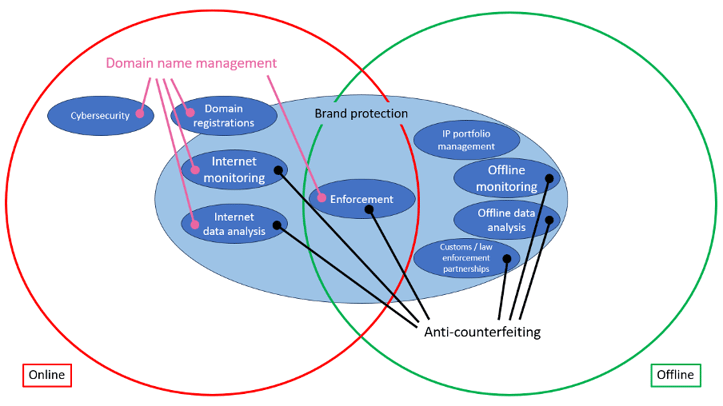
The description of brand protection products and services involves the use of a wide range of terminology, including terms which are frequently used interchangeably, in different ways by different providers, or in ways which do not fully or accurately describe the component parts. In this article, we look to set out a group of terms which can be used to standardise the descriptions. A schematic illustrating the high-level approach is shown in Figure 1.

Figure 1: Schematic of the basic elements of brand protection (and related product and service areas) across both the online and offline worlds
Overall, brand protection sits across the intersection of the online and offline environments. In its broadest sense, it comprises a combination of:
- Monitoring – the detection of potentially relevant (and/or infringing) content
- Analysis – the processes of filtering the data (e.g. removing false positives), prioritising the relevant findings for further action, and using clustering techniques to establish links between findings
- Enforcement – follow-up actions to mediate or remove infringing content
In general, all of these elements can utilise a combination of automated and manual approaches.
The tools and techniques appropriate for use with monitoring and analysis of online vs offline content are, in general, relatively distinct from each other. They typically involve technical approaches (e.g. the use of search and monitoring tools) for online content, and more on-the-ground approaches (information derived from partnerships with customs and law enforcement, physical investigations, etc.) for offline content. Accordingly, these are shown separately in Figure 1.
‘Enforcement’ encompasses a range of approaches. To a high level, these are often categorised as those which primarily relate to online content (e.g. marketplace or social-media takedowns, host- or registrar-level domain takedowns – i.e. online brand enforcement), whilst others (such as physical raids or seizures) are most meaningful when thought of in association with the offline world (i.e. offline brand enforcement). In reality, however, these two areas are not really separate, for a number of reasons:
- The offline world is a key part of the supply chain for infringing goods to be sold online
- In many cases, ‘online’ enforcement may require the use of ‘offline’ elements (e.g. communications via telephone, fax or physical mail) and conversely ‘offline’ enforcement approaches may require e-mail communications or may be associated with individuals who are also responsible for online infringements
- Many of the escalation routes for enforcement actions (IP disputes, litigation, etc.) may be relevant both to online and offline content
Overall, therefore, enforcement is best viewed as a spectrum of approaches which collectively straddle both the online and offline worlds.
It is then possible to use this overall framework to ‘read’ the lists of components relating to specific service areas – e.g. ‘online brand protection’ consists of online monitoring, online analysis and (online) enforcement, together with the defensive-registrations component of an official domain portfolio.
As a next step, it is also helpful to consider how specific service areas ‘map’ into this overall framework. For example, the provision of ‘anti-counterfeiting’ services typically incorporates monitoring, analysis and enforcement across both the online (e.g. e-commerce websites) and offline (e.g. physical manufacture and sales) worlds. Conversely, domain name management – an area which occupies purely the online environment – requires elements of domain name registrations (i.e. the construction of an official domain portfolio), domain-related brand protection against third-party infringements, and (if done appropriately) the use of cybersecurity measures to secure official domains from compromise and attacks. The construction of an official domain portfolio is shown as sitting partly outside and partly inside the considerations of ‘brand protection’, as it encompasses both the registration of ‘core’ domains used for general business operations, and strategic domains (a subset of the ‘tactical’ portfolio) relevant to potential future business expansions, but also the registration of defensive domains (also ‘tactical’) held to prevent infringing use by third parties (i.e. a purely brand-protection-related consideration).
The final piece of this high-level picture, but one of central importance, is the process of IP portfolio management. This is the registration and maintenance of appropriate IP rights such as trademarks (in appropriate classes and jurisdictions), patents, design rights, etc. It is shown as an ‘offline’ element of the overall approach, but comprises a key dependency for effective enforcement across both the online and offline environments. Essentially, it is impossible to operate an effective brand protection programme without having a strong IP rights portfolio in place. The converse is also true; proactive brand protection is often a prerequisite for retaining IP protection. In addition, once a brand protection programme reaches a mature state, it can also help inform the development and evolution of the IP portfolio – insights drawn from trends and patterns in infringements, and subsequent enforcement actions, can feed into the ongoing process of ‘rightsizing’ the portfolio, to balance protection against budget.
Send us your thoughts:
Would you like to read more articles like this?
Building 1000
Cambridge Research Park
CB25 9PD
Fax. 01223 425258
info@iamstobbs.com
Privacy policy
German office legal notice
Cookie Declaration
Complaints Policy
Copyright © 2022 Stobbs IP
Registered Office: Building 1000, Cambridge Research Park, Cambridge, CB25 9PD.
VAT Number 155 4670 01.
Stobbs (IP) Limited and its directors and employees who are registered UK trade mark attorneys are regulated by IPReg www.ipreg.org.uk

